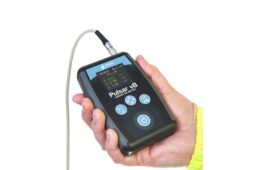At Sensors Expo 2018, Pierre Mars, head of the applications team at Cap-XX, a supercapacitor manufacturer from Australia, explains the supercapacitor demos in their booth.
Using a 800 mF supercapacitor provides the energy to power a 2.9V near-field communication (NFC) 13.5 MHz sensor puck from Silicon Labs. With the charged supercapacitor (above 2.6V) the unit can transmit for a few minutes until the voltage drops to 2.4V.
With an indoor solar cell charging the supercapacitor, it draws 700 µA charging a 170 mF supercapacitor up to 3.6V. When the voltage gets close to 3.6V, the pulse is transmitted and shown on a display. The pulse is about 7 mA at its peak. While it was just across the table at Sensors Expo, it could have been as much as 300 meters away in a real application.
The last demo uses a vibration transducer to charge a supercapacitor. With the supercapacitor’s voltage at nearly 5 V and fully charged, the current level is small. The demo reports a level of 92 lux through an internet gateway to a hotspot communicating over 4G to a network where Mars’ PC is connected to. When communicating, the supercapacitor provides 70 mA and can run for about a minute and the supercapacitor voltages drops to about 4.2V.
In addition to its G-Series and H-Series supercapacitors, Cap-XX offers Thinline (rated as high as 300 mF at nominal 2.75V) and single and dual-cell cylindrical supercapacitors that are rated up to 1.55 µF at 5.4V for the dual-cell units.
Filed Under: Capacitors, Sensor Tips, Energy management + harvesting





Tell Us What You Think!